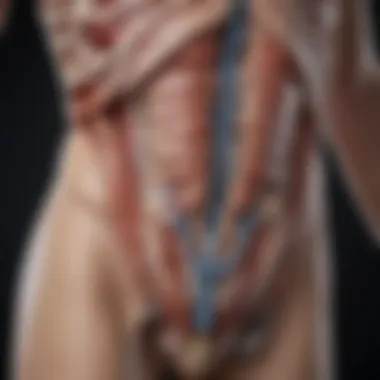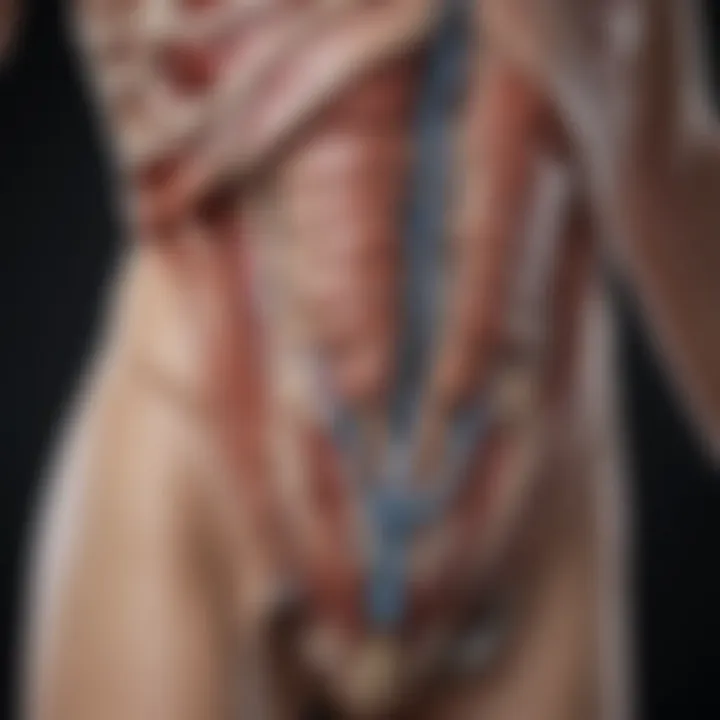Techniques and Benefits of Portacath Access


Intro
Portacath access is a crucial topic in the realm of modern medical practices. It plays a significant role in the management of patients who require long-term intravenous therapy. By providing a reliable way to administer medications, nutrients, and fluids, portacaths have transformed how healthcare professionals approach patient care, particularly in oncology and other chronic conditions. This guide seeks to elaborate on the various techniques involved in accessing portacaths, the benefits they present to patient health, and the challenges that medical staff may encounter in their day-to-day operations.
Understanding portacath access is not just for seasoned practitioners but also for students and researchers. This knowledge can foster better communication, enhance patient outcomes, and promote a more holistic approach to healthcare. In the pages to come, we will explore the nuances of portacath access, aiming to provide clear insights for anyone involved in health sciences.
Summary of Objectives
This article aims to provide a comprehensive examination of portacath access techniques, detailing their benefits and challenges faced by healthcare providers. By shedding light on this vital aspect of medical intervention, we hope to improve awareness and understanding among students and healthcare professionals alike.
Importance of the Research
The significance of exploring portacath access goes beyond just the mechanics of insertion. The insights derived from this topic can lead to improved patient compliance, fewer complications, and better management of chronic conditions. It is imperative to acknowledge the importance of nuanced discussions around such topics to improve outcomes for patients in various healthcare settings.
Results and Discussion
Presentation of Findings
Research indicates that the techniques used for portacath access are diverse, each with its own set of pros and cons. Some of the most commonly employed techniques include:
- Palpation Technique: Involves feeling for the port and accessing it directly. While straightforward, it requires adequate skill to avoid complications.
- Ultrasound-Guided Access: Using imaging techniques to locate the port can significantly reduce the risk of complications and improve accuracy.
- Radiologic Assistance: In complex cases, the intervention of radiology may be needed to ensure proper placement and access to the portacath.
Each technique serves different needs and contexts, underscoring the importance of tailored approaches in practice.
Implications of Results
Healthcare professionals face several challenges with portacath management:
- Infection Risks: As with any invasive procedure, there's a constant risk of infection. Regular training on sterile techniques is vital.
- Patient Anxiety: Patients often experience anxiety related to portacath insertion. Clear communication and education can help alleviate some of these fears.
- Technical Complications: Issues such as misplacement, failure to access the port, or complications during use can arise. Continuous professional development can mitigate these risks.
"Knowledge is power, especially in the dynamic field of healthcare."
By fostering ongoing discussions around the access techniques and their implications, we can contribute to better patient outcomes and a more efficient healthcare system.
Preface to Portacath Access
Understanding portacath access is essential for anyone seeking insight into modern medical practices. As we navigate this discussion, we uncover the multifaceted nature of portacaths and their role in various healthcare scenarios. Essentially, a portacath, short for port-a-cath, serves as an implanted access point for long-term intravenous (IV) therapy. This one device carries the weight of frequent medication regimes, routine blood draws, and other essential medical interventions.
Definition of Portacath
A portacath is a small medical device placed beneath the skin that provides direct access to a central vein. This means fewer needle sticks for patients as they go through treatments like chemotherapy or long-term antibiotics. Typically made of a plastic catheter, a portacath is inserted under local anesthesia and can last for years with proper care. The resilient nature of this device makes it suitable for patients who require repeated vascular access, making their treatment more manageable and less painful.
Historical Development
The journey of the portacath isn’t just a tale of technology but of evolving patient care. The earliest prototypes surfaced in the 1970s, quickly gaining traction for their capabilities in treating cancer patients. Back then, the standard treatment involved numerous needle sticks, leaving many patients feeling like pincushions. As the medical community recognized the toll of such a practice, the portacath emerged as a solution. Over time, advancements in material and design have only enhanced its reliability and acceptance in clinical practice. Today, it stands as a testament to improved patient comfort and healthcare efficiency.
Current Applications in Healthcare
Presently, portacaths find their place in numerous medical conditions and treatment plans. They are frequently utilized in:
- Chemotherapy: Many oncology patients rely on portacaths for direct access to their bloodstream, allowing better medication delivery.
- Blood Draws: For patients needing regular blood tests or transfusions, portacaths provide a less invasive alternative to peripheral veins.
- Antibiotic Treatment: Long-term IV antibiotics are crucial for patients with chronic infections. Portacaths simplify this necessary treatment by reducing the number of needle sticks.
"The advent of portacaths has revolutionized patient care, taking the sting out of treatments and making healthcare experiences far less daunting for countless individuals."
Recognizing the importance of this access method not only assists in reducing anxiety for the patient but also streamlines processes within healthcare facilities, allowing clinicians more time to focus on critical care. The implications of this are broad, impacting both patient health outcomes and the efficiency of care delivery.
Importance of Portacath Access
In the landscape of modern medicine, the role of portacath access cannot be overstated. It serves as a critical conduit for various medical treatments, enabling healthcare professionals to deliver care efficiently and with greater efficacy. When discussing the importance of this topic, it’s essential to delve into specific elements that underscore its significance in clinical settings.
Facilitating Intravenous Therapy
Portacaths facilitate intravenous therapy, which is often the backbone of many treatment plans for patients with chronic illnesses. By providing direct access to a central vein, these devices allow for the administration of fluids, medications, and blood products in a controlled manner. This is especially vital for patients who require long-term treatment. The quick access can mean the difference between swift care and potential complications. With a portacath, interruptions in treatment can be minimized, ensuring that patients adhere to their therapeutic regimens without frequent needle sticks.


Long-Term Medication Administration
The use of portacaths is prevalent in long-term medication administration. Certain conditions, like cancer, necessitate consistent infusions of chemotherapy. Rather than repeatedly inserting needles, which can cause discomfort and anxiety for patients, portacaths provide a more stable option. This not only improves patient compliance but also allows for higher concentrations of medications to be delivered directly into the bloodstream without the risk of damaging smaller veins. Furthermore, using a portacath allows for more complex therapies, like TPN (Total Parenteral Nutrition), to be safely managed over extended periods.
Enhanced Patient Comfort
Patient comfort is a cornerstone of effective medical treatment, and portacaths significantly enhance this aspect. By reducing the need for frequent venipunctures, patients experience less pain and anxiety related to needles. Many patients express a sense of ease, knowing they have a reliable access point, which contributes to a better overall treatment experience. Additionally, some patients report enjoying higher mobility with a portacath in place, as they can manage daily activities without the constant worry of accessing a vein.
"A common comment among patients is the relief they feel when they no longer have to endure repeated needle sticks—that alone can enhance overall well-being and compliance with therapy."
The versatility and utility of portacath access fundamentally transform patient care, creating a more effective and compassionate healthcare environment. The importance of understanding these components goes beyond mere technicalities; it’s about grasping how such a simple device can have profound implications on a patient's journey through treatment.
Techniques for Portacath Access
The ability to efficiently access a portacath is essential for healthcare professionals, as it directly influences patient outcomes and the efficacy of treatment. Various techniques underpin this process, ensuring both safety and efficacy. Understanding these methods and their implications not only enhances the capabilities of practitioners but also offers reassurance to patients who rely on these access points for continuous treatments.
Insertion Procedures
The primary step in utilizing a portacath is the insertion of the device itself. This process is not merely a procedural formality; it sets the stage for all subsequent access and care.
- Preparation: Proper preparation is critical. This includes ensuring sterile conditions, conducting a thorough assessment of the patient's anatomy, and obtaining informed consent. A sterile field is essential to minimize infection risks during the procedure.
- Technique: The common approach involves a small incision beneath the skin, where the catheter will be inserted. A guidewire is often used to facilitate catheter placement. An experienced clinician will carefully navigate the access to the central venous system, typically the subclavian vein or internal jugular vein. Some practitioners may adopt ultrasound guidance for improved accuracy, especially in patients with challenging anatomy.
- Finalization: After the catheter is properly positioned, the access port is attached, and the incision is sutured. Ensuring proper exit and entry points for the catheter helps prevent complications later on. This phase is vital, as any errors made during insertion can lead to long-term issues down the road.
Maintenance Protocols
Once a portacath is successfully inserted, maintaining it effectively is crucial for preventing complications and ensuring it functions well over time.
- Regular Flushing: One of the most significant aspects of maintenance is flushing the port with saline. This helps to keep the line patent and prevents clots from forming. It's typically recommended to flush the port every four to six weeks, depending on usage.
- Dressing Changes: Periodic changes of the dressing around the port are necessary to maintain hygiene and reduce infection risks. Healthcare teams usually follow established protocols for how frequently these changes should occur.
- Monitoring for Signs of Complications: Vigilant monitoring involves assessing the port site for signs of infection, inflammation, or leakage. Identifying issues early is vital to avoid more severe complications.
Dealing with Complications
Complications, while often thought of as rare occurrences, can and do happen. Being prepared for such instances can drastically alter outcomes.
- Infection Management: If an infection is suspected, swift action is required. This might involve culture tests, initiating antibiotic therapy, and evaluating the need for catheter removal.
- Catheter Occlusion: Blockages can happen due to blood clots or fibrin sheaths. In cases of occlusion, specific methods such as using thrombolytic agents may be employed. If all else fails, catheter replacement might be the only option.
- Mechanical Complications: These include issues like catheter displacement or breakage. Knowing how to promptly handle these situations reduces stress for both patients and medical staff.
"The most critical moment in handling portacaths isn't just insertion; it’s how we maintain and troubleshoot them that defines patient care quality."
Overall, effective techniques for portacath access play a pivotal role in ensuring long-term success in treatment protocols. Each phase, from insertion to ongoing maintenance and complication management, requires a careful balance of skill and knowledge to safeguard patient well-being. By prioritizing these techniques, healthcare providers not only enrich the patient's experience but also pave the way for more efficient therapeutic outcomes.
Patient Considerations and Education
Understanding the nuances of patient considerations and education is a cornerstone in effective portacath access. Educating patients about portacaths not only elevates their comfort levels but also fosters compliance and successful health outcomes. When healthcare professionals prioritize patient-centric dialogue, it leads to a more informed cohort of patients, which in turn paves the way for better management of their own health. There are several critical aspects to consider—ensuring patients are well-informed and appropriately assessed before embarking on a treatment journey, especially when involving devices like portacaths.
Assessing Patient Eligibility
Before getting down to brass tacks with portacath insertion, assessing patient eligibility is indispensable. Not every patient is fit as a fiddle, and understanding their medical history is paramount. This means everything from evaluating previous venous access to understanding whether the patient has any underlying conditions that could complicate catheter placement.
Complications can stem from a variety of sources, including:
- Comorbidities: Conditions like diabetes or renal failure can significantly influence outcomes.
- Venous Anatomy: A thorough examination of the patient's veins can indicate potential challenges during the insertion process.
- Age and Size: Elderly patients or those with smaller veins might have different requirements or risks.
A comprehensive screening process that involves lab work and imaging studies can go a long way. Not only does this help in determining eligibility, but it also gives healthcare providers insight into developing tailored treatment plans that meet individual needs.
Informed Consent Process
Once eligibility is determined, the informed consent process becomes the next line of defense. This isn't just a formality. It underlines a patient's right to be in the know about their healthcare choices. Clear communication about the procedure, including its risks and benefits, should be laid out transparently.
This process can involve:
- Discussing the Procedure: Patients should be walked through what insertion entails, duration, and aftercare.
- Navigating Risks: Candidates should be made aware of potential complications, including infection, thrombosis, or catheter malposition.
- Exploring Alternatives: Sometimes a portacath may not be necessary. Discussing other forms of venous access becomes critical to responsible patient care.
Getting written consent is crucial. It is more than just a signature; it symbolizes that the patient understands what they are agreeing to. A well-informed individual is likely to make choices that reflect their values and concerns.
Patient Education Materials


To bolster the understanding acquired during consultations, creating effective patient education materials is essential. These can be in form of pamphlets, video aids, or digital resources tailored to meet varying levels of health literacy among patients.
Consider including:
- Visual Aids: Diagrams and illustrations can help clarify complex processes and anatomy.
- Multilingual Resources: Language can often be a barrier; providing materials in multiple languages ensures everyone is informed.
- FAQs Section: Common questions patients might have can be addressed upfront, minimizing confusion.
- Follow-Up Information: Guidance on post-insertion care and signs of complications encourages proactive patient involvement.
"An informed patient is an empowered patient. Understanding their treatment journey fosters compliance and satisfaction."
Benefits of Portacath Access
The use of portacaths in medical practice has been a game changer, particularly in the realm of intravenous therapies that require frequent access to the vascular system. Patients receiving long-term treatments, such as chemotherapy or those requiring extended antibiotic regimens, greatly benefit from this access method. The advantages of portacath access extend beyond mere convenience; they influence overall patient compliance, comfort, and welfare. Let’s dive deeper into the three main benefits that highlight the significance of this access method.
Reduced Frequency of Venipuncture
One of the most immediate advantages of utilizing a portacath is the reduction in the frequency of venipuncture. For patients engaged in therapies requiring regular blood draws or medication infusions, a portacath provides a reliable access point that alleviates the distress of repeated needle sticks. Instead of jabbing veins multiple times a week, healthcare providers can connect to the port without causing the patient unnecessary discomfort.
- Less physical distress: Needle phobia is a common issue among patients, especially those undergoing long-term treatment. Having a portacath means fewer traumatic experiences for them.
- Better vein preservation: Frequent punctures can lead to damage or scarring of veins, limiting future access possibilities. Ports can help in preserving the integrity of peripheral veins.
- Improved adherence to treatment: When patients face fewer painful experiences, they are more likely to stay committed to their treatment regimens, leading to better health outcomes.
Improved Drug Delivery
Another key benefit is enhanced drug delivery. Portacaths allow for a consistent and efficient way to administer medication. Unlike traditional methods, which can vary in effectiveness based on each attempt at venipuncture, ports facilitate a more stable and controlled delivery system.
- Consistent flow rates: The port's design supports reliable and consistent flow rates, which are critical for certain medications that require precise dosing.
- Access to larger volumes: In emergencies or during intensive therapy cycles, the capacity of a port makes it easier to deliver larger drug volumes promptly.
- Minimized systemic complications: Using ports can also reduce the incidence of venous irritation and inflammation often seen with peripheral lines, leading to smoother administration and fewer complications.
Minimization of Infection Risks
In an era where infection control is paramount, portacaths stand out with their lower infection rates compared to other intravenous access methods. This reduction is crucial for both patient safety and the effectiveness of the treatment regimen.
- Lower risk of catheter-related bloodstream infections: Studies indicate that patients with portacaths experience far fewer infections compared to those with peripheral catheters that are inserted multiple times.
- Easier maintenance protocols: While ports do require maintenance, their design often simplifies cleaning and access techniques which can further minimize infection opportunities.
- Longer lifespan: When managed correctly, a port can be used for prolonged periods, reducing the need for repeated insertions and the associated infection risks that come with them.
These benefits offer a strong rationale for the adoption of portacaths in clinical practice, reflecting their growing relevance in today’s healthcare landscape. As we delve deeper into the ongoing challenges associated with portacath management, it’s essential to understand how these advantages play a pivotal role in patient care.
Challenges in Portacath Management
Managing portacaths is not all smooth sailing. While these devices greatly enhance the quality of care, they also come with their unique trials that healthcare professionals must navigate. Understanding these challenges is vital, as it helps in improving practices, ultimately benefiting patient outcomes. The focus here is on some critical aspects: common complications that can arise, the technological hurdles that pose risks, and the allocation of resources within healthcare facilities to support proper portacath management.
Common Complications
It’s no secret that portacaths, whilst reliable, can lead to several complications during their lifespan. Some of the more frequently encountered issues include:
- Infection: This is perhaps the most serious concern, as deep-seated infections can lead to systemic issues if not promptly addressed. The risk of infection persists due to the catheter's insertion site remaining open to the external environment.
- Thrombosis: The formation of blood clots within the catheter is another challenge. This can lead to complete blockage, making it difficult or impossible to administer therapies.
- Catheter Malposition: If the portacath is not correctly placed, it may not function as intended, leading to significant clinical complications.
Bottom line, addressing these common complications requires astute observation skills and timely intervention by healthcare providers. Regular monitoring and patient education play crucial roles in prevention.
Technological Limitations
The technological landscape surrounding portacath access continues to evolve, yet there remain some limitations that hinder optimal use. For instance, the materials used in catheter construction, while engineered for durability, may still allow for friction and clogging over time. Currently, most catheters do not have built-in mechanisms for easy cleaning or self-flushing, which can lead to increased maintenance efforts.
Moreover, healthcare facilities might not always have access to advanced imaging technology to correctly place the portacath. The reliance on outdated devices can result in misplacements, causing not only additional procedures but hassle for patients. In a world increasingly driven by technology, the lag in secure access methods can be frustrating, emphasizing the need for continual investment in innovation and upgraded equipment.
Resource Allocation in Facilities
Healthcare facilities often operate under tight budgets and limited staff. This constraint directly influences portacath management. Appropriate training for staff handling these intricate devices is paramount. However, when resources are stretched thin, creating regular training programs can become a low priority.
Additionally, maintaining an adequate supply of materials for portacath maintenance, including cleansing agents and monitoring devices, becomes challenging. Facilities may end up prioritizing availability based on immediate needs, which can compromise comprehensive care in the long run.
Improper resource allocation can also lead to increased wait times for procedures, which, in turn, affects patient health outcomes. It's imperative for healthcare administrators to balance caregiving needs against budget limitations to ensure efficient portacath management.
In summary, addressing the challenges of portacath management through proactive strategies can significantly enhance patient care and outcomes. The need for constant vigilance, continued training, and technological advancements cannot be overstated.
Guidelines and Best Practices
In the complex landscape of portacath access, having robust guidelines and best practices is not just a preference but a necessity. These practices act as the backbone for healthcare professionals who navigate the intricacies of accessing a portacath. It is vital to develop protocols that ensure patient safety while maximizing the efficiency of medical procedures.


Professional Training Requirements
Training is fundamental in ensuring that healthcare providers are well-equipped to manage portacath access effectively. Standardizing training programs can provide healthcare workers with the skills they need to avoid complications and improve patient outcomes.
The core areas of focus during the training should include:
- Anatomical Understanding: Knowledge of the vascular anatomy relevant to portacath insertion and maintenance is paramount. This knowledge allows clinicians to make informed decisions during procedures.
- Hands-On Practice: Simulation-based training offers practical experience. Utilizing models or simulations can build a clinician’s proficiency before they engage in real-life applications.
- Infection Control: Given the risks associated with invasive procedures, training programs must underscore the importance of stringent infection control measures, including proper hand hygiene and sterile technique.
Quality Assurance Measures
Implementing quality assurance measures is essential to ensure that portacath access systems are functioning at their best. Quality assurance involves systematic monitoring and evaluation of different components of portacath management.
Some key aspects include:
- Reevaluation of Protocols: Regularly revisit and update access protocols based on the latest evidence or insights gleaned from recent complications or success stories.
- Patient Feedback: Gathering input from patients regarding their experiences with portacath access can provide invaluable insights into areas needing improvement. Patient experience should be an integral part of quality measures.
- Auditing Practices: Conducting periodic audits of access procedures helps in identifying deviations from best practices and developing corrective actions.
Evaluation of Outcomes
Evaluating outcomes is essential for understanding the effectiveness of portacath access techniques. This practice goes beyond mere numbers; it encompasses a comprehensive view of patient experiences and clinical results.
Consider the following evaluation strategies:
- Tracking Complications: Maintaining a log of complications can aid in identifying trends that could inform future training and procedures.
- Assessing Patient Satisfaction: Utilizing surveys to measure patient satisfaction can reveal insights about comfort and perceived care.
- Outcome Metrics: Set clear metrics for success, such as reduced infection rates or minimized need for replacements. Measuring these can shape a continuous improvement model in healthcare settings.
"The value of developing guidelines lies not just in compliance but in fostering an environment where patient safety and clinical excellence are at the forefront of medical practice."
Adopting these guidelines and best practices can create a framework aimed at enhancing patient care and improving procedural outcomes in portacath access.
Future Perspectives on Portacath Usage
As the landscape of healthcare evolves, so too does the role of portacaths in patient management. Understanding future perspectives on portacath usage is paramount for healthcare professionals, researchers, and educators, especially when considering how these devices can adapt to meet changing needs. There's a gripping need to delve into advancements, patient demographics, and policy challenges that shape the future of this essential medical access technique.
Advancements in Technology
Technological innovation is reshaping many aspects of healthcare, and portacath access is no exception. The introduction of smarter, more efficient devices can enhance access methods, reduce patient discomfort, and minimize complications.
For example, minimally invasive insertion techniques are gaining traction. Using ultrasound-guided placements not only improves the accuracy but also reduces time under sedation. Additionally, biodegradable materials are on the horizon for use in catheter construction, making them safer and more sustainable. Another exciting development is the integration of telehealth technologies, allowing for remote monitoring of portacath sites, which promotes timely interventions and enhances patient safety. In sum, these technological advancements promise to streamline procedures, enhance outcomes, and facilitate better patient experiences.
Changing Patient Demographics
It’s clear that healthcare systems must adapt to a shifting patient population. With aging populations and a rise in chronic diseases, we see increased demand for long-term venous access solutions like portacaths. Hospitals and clinics are preparing to accommodate these challenges in various ways. For one, there’s a heightened emphasis on personalized healthcare. Different demographics require tailored approaches, whether it’s children needing adjustments for size or elderly patients requiring more delicate handling due to comorbidities.
Furthermore, cultural competence in healthcare is essential. Engaging with diverse populations regarding their unique values and needs can enhance their experience with portacath management. As healthcare professionals become more attuned to these dynamics, the effectiveness of portacaths as a care solution can only improve.
Policy and Practice Challenges
The road ahead is not without its hurdles. Amidst the ever-advancing technology and changing demographics, policy and practice challenges will continue to affect portacath usage. Resource allocation is a critical issue as hospitals strive to provide cutting-edge treatment while managing costs. Funding limitations may hinder the ability to invest in the latest technologies or adequately train staff in new techniques.
Moreover, the complexity of healthcare policies can sometimes create a quagmire of compliance issues, especially when it comes to safety protocols and standards for catheter care. Proper education on the best practices must be prioritized within clinical settings to mitigate risks associated with infection and complications.
"Portacaths are a backbone for patients needing long-term access. Yet, we must address systemic challenges to ensure their use is as effective and safe as possible."
Epilogue
The conclusion functions as the heart of this article, knitting together the vast tapestry of information regarding portacath access. It serves as a touchstone for what has been discussed while directing attention to the critical aspects that inform both practitioners and students alike about the implications of portacath management in clinical settings.
Summarization of Key Points
As we summarize, several key points emerge that highlight the significance of portacath access:
- Techniques and Methods: The various techniques addressed here, such as insertion procedures and maintenance protocols, lay the fundamental groundwork for understanding how to utilize portacaths effectively.
- Patient Focus: The focus on patient comfort and the low frequency of venipuncture reinforces the value of portacaths in improving the patient experience during long-term therapies.
- Challenges and Solutions: The challenges faced by healthcare providers, including common complications and resource limitations, are just as vital as the benefits they provide. In discussing them, we've lighted a path for future improvements.
It's clear that while portacaths offer considerable advantages, their effectiveness hinges on the mastery of techniques and the awareness of the challenges involved.
Call for Further Research
Despite the strides made in understanding portacath access, the field is ripe for further exploration. There is much more to uncover about the efficacy of various insertion methods and long-term maintenance protocols. Here are a few areas that invite additional inquiry:
- Patient Outcomes: Studies focusing on long-term patient outcomes versus traditional methods can yield insights into overall healthcare efficiency and patient satisfaction.
- Technological Innovations: As technology progresses, ongoing examinations of how new tools can improve access and minimize complications should be pursued rigorously.
- Guidelines Development: Developing standardized guidelines based on empirical research will improve consistency in practice and potentially enhance patient safety.















